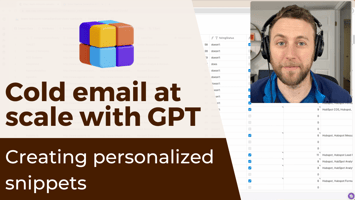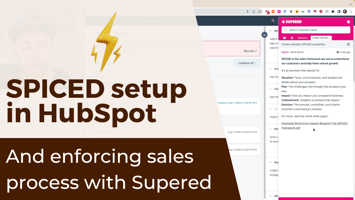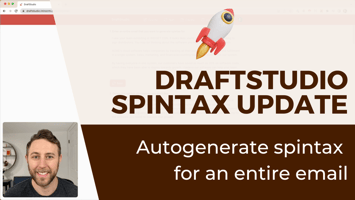I want to share how we're using GPT to create personalized snippets at-scale for cold email. In...
Avoid overpaying for sales prospect data with Clay
I'm excited about a new tactic for building lists for sales teams. When we go the extra mile to get email addresses, mobile numbers, LinkedIn profiles, and more.
A typical single database approach is where you subscribe to a single database and then get what you get. Maybe they have premium tiers to unlock certain data.
But it doesn't have to be this way.
In Clay, we can conditionally decide to pay premium providers for premium data for premium prospects.
Or in a negative sense, you can avoid overpaying for data for prospects who may technically fit your ICP but aren't worth the cost. Maybe they're on the bubble in terms of qualification.
In this video, I show how we can set a threshold where we will only go to additional providers if a company has a headcount over X. Watch below.
[00:00:00] Pardon my casual dress. I got back from a run. I was building a list and I been working on something that I think is a pretty interesting way to. Think about. How much you want to invest in getting prospect data. So I've got clay pulled up here and I've just have a little example based on the work I was doing for a campaign that I was running for a client.
[00:00:21] When you take a traditional single data provider approach. You just. Pay, whatever it costs to get the data and whatever data they have they have. And that's it. However, when you're using a tool like clay, or when you're using multiple different providers, you have a different decision to make, which is how much do I want to pay?
[00:00:40] At any given time. And is there a price that I don't want to pay? And why. So here, basically going to show you where we can basically pay more for data. As we feel like a prospect is more valuable, but paid less. When we feel like the prospect is. Is potentially worth less lower deal value, lower deal size.
[00:00:59] I've got a list of three, just random. Uh, e-commerce companies that are all running Shopify. Arizona, bio clarity. Chef's cut real jerky company. Uh, now I'm not going to show actual email addresses or phone numbers or anything like that. And this is just publicly available information of the executives at these companies.
[00:01:19] I've got the company, LinkedIn page, the employee count, and then I'm searching LinkedIn. To find people at these companies. So we started with the domain, find the people. Now I need contact information for them in case I want to contact them. In addition to LinkedIn, maybe I want to send him an email or maybe even give him a call, get a mobile number.
[00:01:38] Um, so I was able to find email addresses for two of them using clay pretty easily. And then I set this requirement. Basically I set a conditional run requirement where he said, okay, If you can't find an email address with clay and the company has at least 10 employees, then I want to use this additional, more expensive provider.
[00:02:00] To spend more, to get an email address for this contact. Now, since this company, bio clarity, doesn't meet that employee account number. I'm not running that search. To get that email address, even though technically they could fit based on the ICP, you know, parameters there's only so much I'm willing to pay for that contact information.
[00:02:20] Now looking at phone numbers and this, and so you're supporting a sales rep. Who's doing omni-channel outreach and you want to get a mobile number, especially. Clay was able to get the first phone number, which is great with that default one, but they didn't get ones for the other two. And again, what I sat here as a conditional circumstance. So I'm saying, look, run. If you can get the mobile number.
[00:02:39] Uh, from clay. Great. But if you can't and the company has at least 10 employees, then I want to use this more expensive provider. Now, in this case, clay didn't have this third number here for this company at the bottom. Um, chef's cut real jerky company, but this other provider, which is significantly more expensive, did.
[00:02:58] Um, so the idea that I just am encouraging you to think about here and that we've been thinking about as we build lists is the. ROI, uh, you know, what is the point at which it makes sense to spend more? Now, in this case, we arbitrarily said, okay, 10 employees, if a company has 10 employees or more, we're willing to pay extra. If they have fewer than 10, if we can get the data for less than great. But if we can't, we're not going to, you know, over pay for it, basically.
[00:03:20] And, uh, as you do segmentation, it can allow you to do different types of campaigns where you may have a part of a list where they just get email and then another part of the list where you have email and phone, and that's the one that you're going to be maybe initiating via a sales engagement platform, and then having tasks created for sales reps to do phone and, uh, you know, LinkedIn and other types of follow-up maybe more manually.
[00:03:43] Um, so. I'm curious if you're doing anything like this, what you think about it, what you think about the approach? I don't have a, a catchy name for it, but basically it's you pay more when you think it's worth more? And, uh, this is something we've been doing increasingly to try to get better segmentation and try to get the best possible yield out of any, given less that we're building.
[00:04:01] So let me know what you think.



